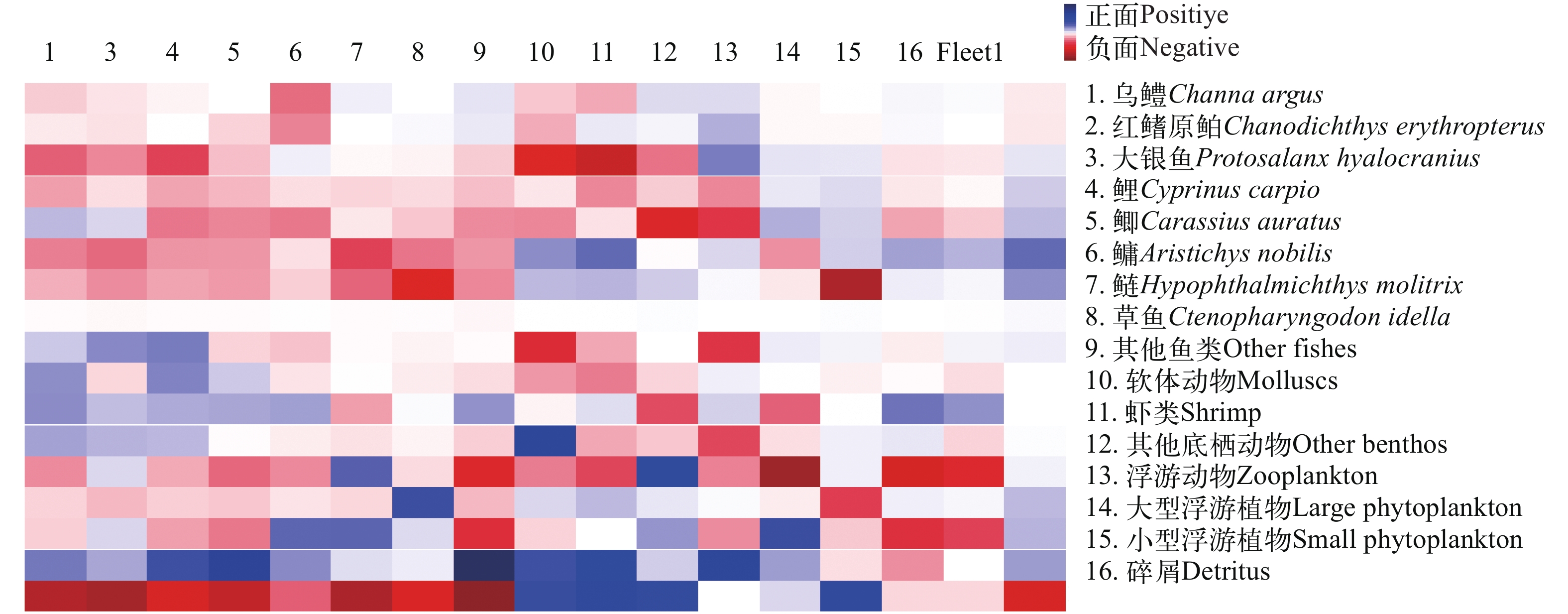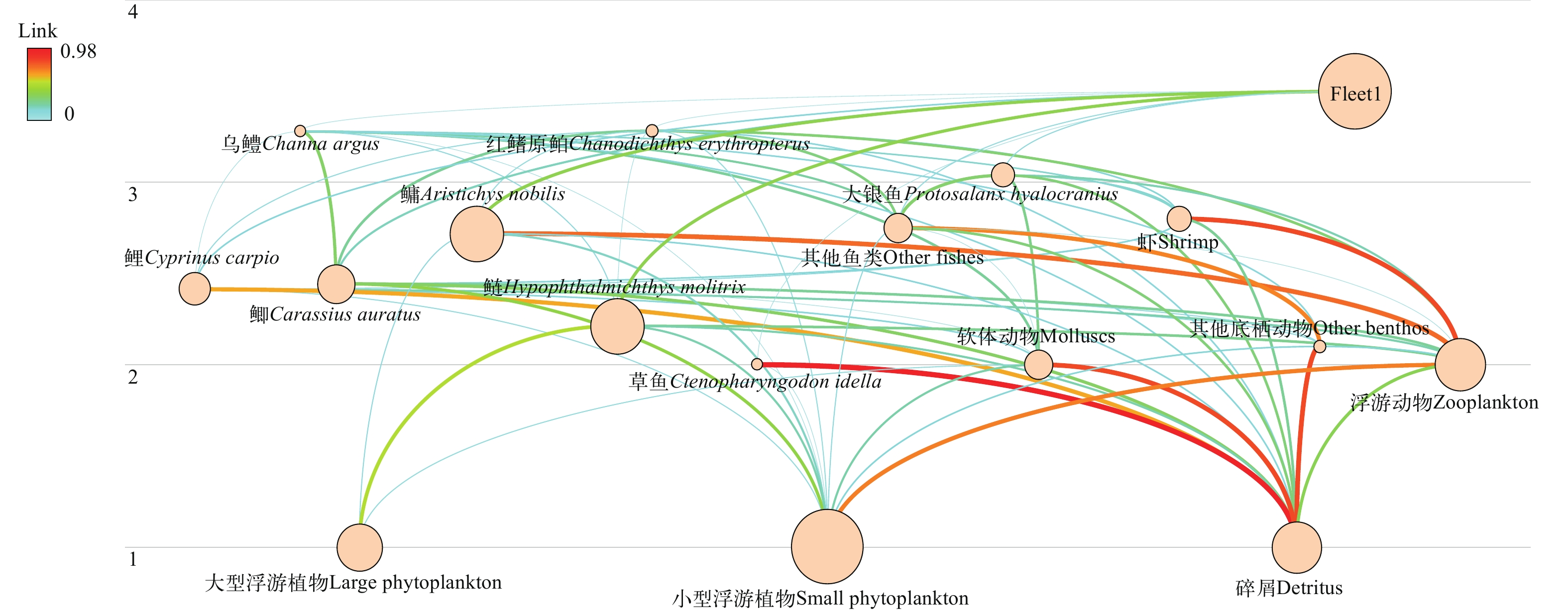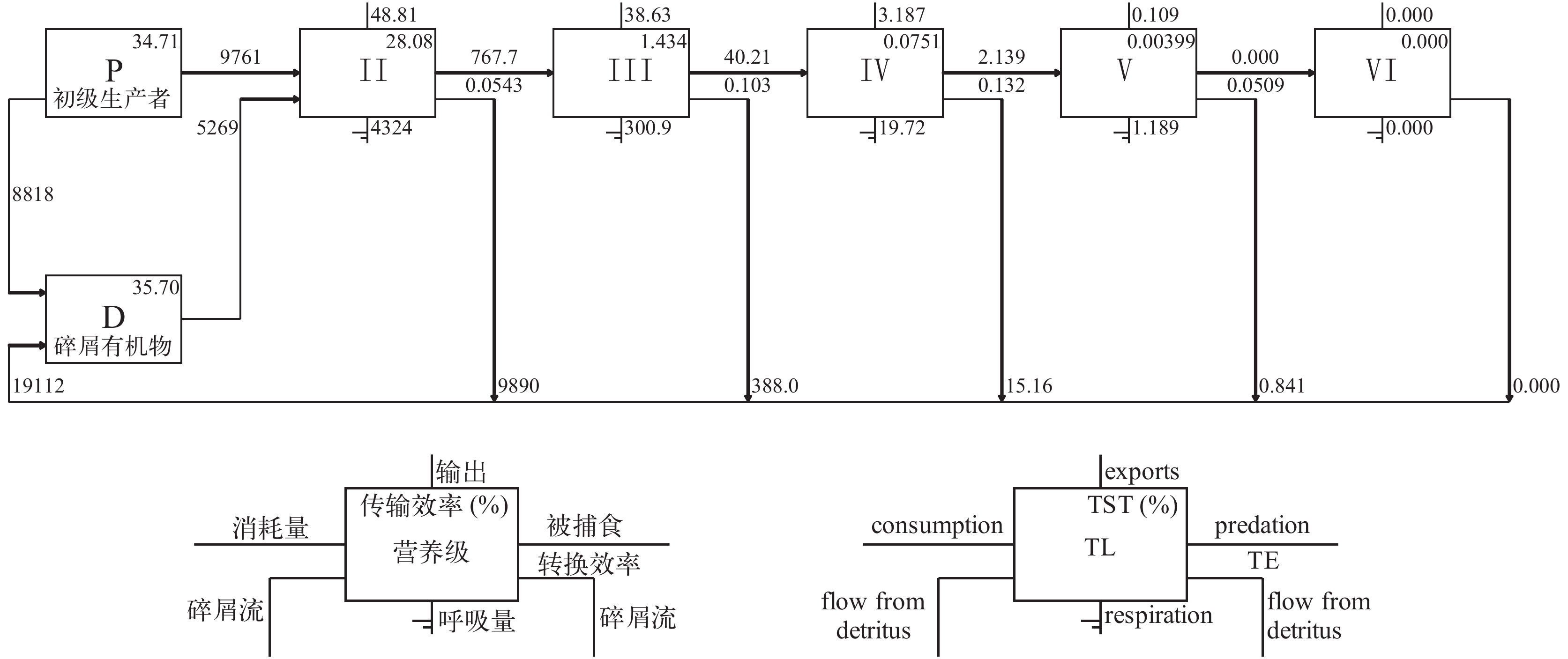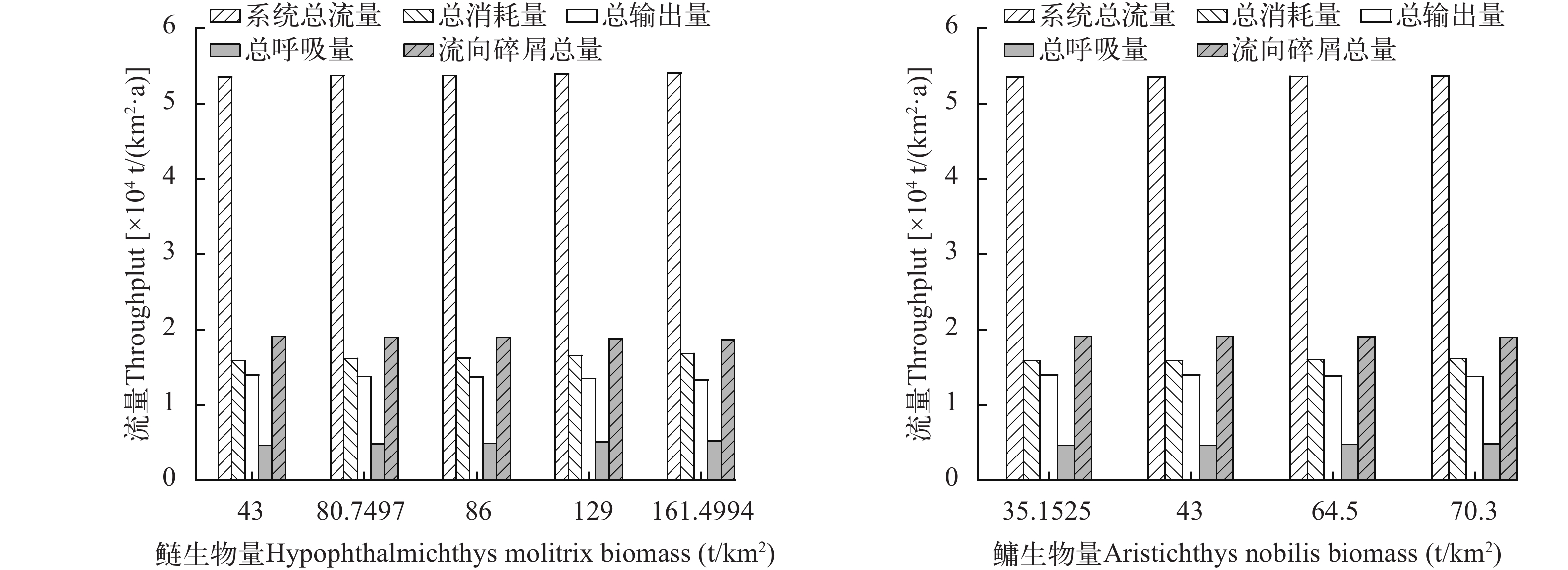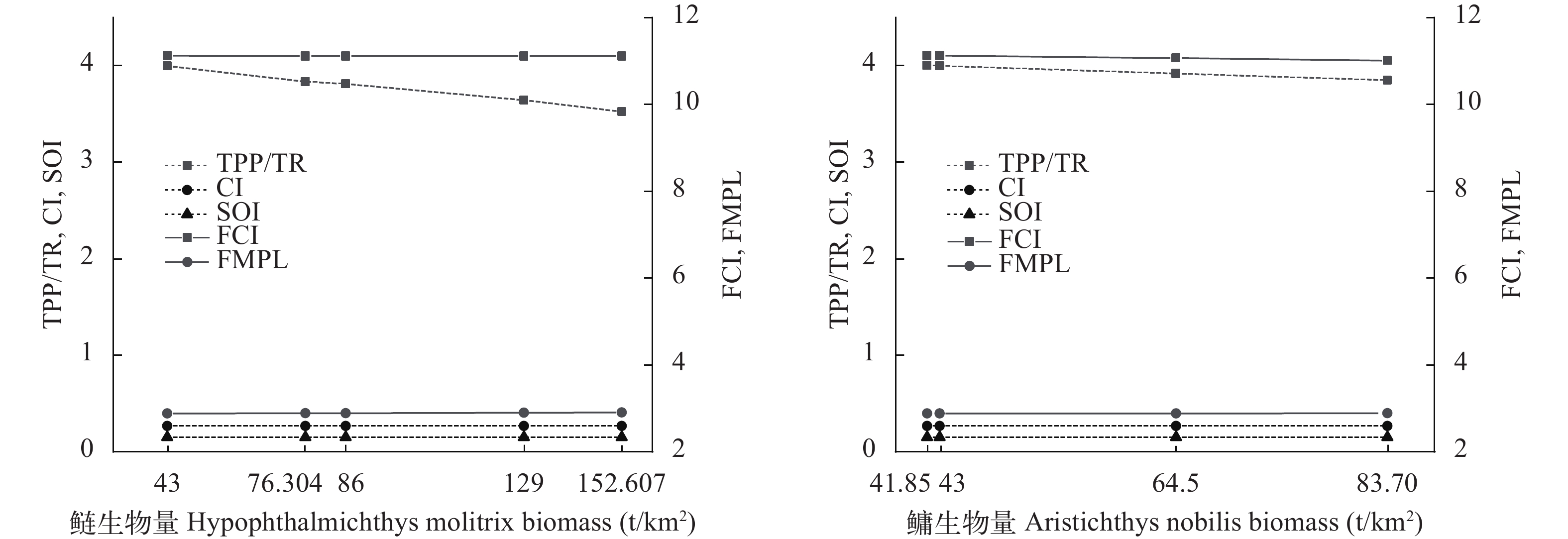ECOLOGICAL SYSTEM CHARACTERISTICS AND ECOLOGICAL CAPACITY OF HYPOPHTHALMICHTHYS MOLITRIX AND ARISTICHTHYS NOBILIS IN THE ZHANGZE RESERVOIR BASED ON ECOPATH MODEL
-
摘要:
为明晰漳泽水库生态系统的基本特征, 估算滤食性鱼类鲢(Hypophthalmichthys molitrix)、鳙(Aristichys nobilis)的生态容量, 探究鲢鳙增殖放流过程对生态系统的影响, 根据2022—2023年的渔业资源调查数据构建漳泽水库Ecopath模型。结果显示, 漳泽水库生态系统的联结程度相对紧密, 整体上稳定性较差且处于不成熟阶段。鲢、鳙的生态容量分别为161.5和70.3 t/km2, 分别为当前生物量的3.549和1.947倍, 渔业生物量增长潜力显著。鲢、鳙增殖至生态容量过程中, 漳泽水库生态系统的总初级生产量/总呼吸量值分别降低0.47和0.15, 系统连结指数(CI)和Finn平均路径长度(FMPL)略有增大, 说明生态系统的能量利用效率有所提高, 生态系统复杂性和成熟度趋于提高。考虑将鲢、鳙生物量分别调整为最大可持续产量80.75和35.15 t/km2, 提高鲢鳙生产量的同时, 有助于生态系统成熟度的提高。以上结果反映了漳泽水库生态系统的发展状况, 同时可为渔业增殖管理提供参考。
Abstract:Ecopath is a modeling tool utilized for analyzing the structure and function of marine and freshwater ecosystems, providing an effective means to assess the structure and energy flow within food webs across various ecosystems. Numerous scholars have employed the Ecopath model to establish ecosystem models for oceans, ponds, lakes, estuaries, and reservoirs, aiming to explore ecosystem structure, function and energy flow characteristics, as well as assess the phylogenetic status and maturity. Additionally, the model has been applied to study the ecological capacity of target species in marine ecosystems such as Wangjiadao Islands and Daya Bay, aiding in the evaluation of breeding and releasing activities. However, the use of the Ecopath model to study the ecological capacity of target species in inland lake reservoir ecosystems, particularly during breeding and releasing activities, requires further investigation. To elucidate the fundamental characteristics of the Zhangze Reservoir ecosystem, estimate the ecological capacity of filter-feeding fish species such as silver carp and bighead, and explore the impact of silver carp proliferation and release on the ecosystem, this study employed the Ecopath with Ecosim 6.6.5 (EwE) software package for modeling and analysis. The Ecopath model of Zhangze Reservoir was constructed based on fishery resource survey data from 2022 to 2023, dividing the ecosystem into 16 functional groups based on ecological niches and feeding characteristics of organisms. The results showed that the trophic level of each functional group ranged from 1 to 3.31. The energy conversion efficiency of primary producers and detritus stood at 9.04% and 9.25%, respectively, with the total energy conversion efficiency of the ecosystem at 9.04%. Moreover, the total flow of each trophic level exhibited an inverse proportion to its trophic level, conforming to the ecological energy pyramid law. The total annual flow of the Zhangze Reservoir ecosystem was measured at 53531.34 t/km2, with a system linkage index (CI) of 0.267, system omnivorous index (SOI) of 0.149, Finnish circulation index (FCI) of 11.12%, and the Finnish average track length (FMPL) of 2.881. The degree of connectivity among ecosystem functional groups was relatively close, yet the food web structure lacked complexity, generally indicating an immature stage. The ecological carrying capacities of silver carp and bighead carp were estimated at 161.5 and 70.3 t/km2, respectively, representing 3.549 and 1.947 times the current biomass, suggesting significant potential for fishery biomass growth. During the process of silver carp and bighead carp reaching their ecological carrying capacities, the total primary production and total respiration values of the Zhangze Reservoir ecosystem decreased by 0.47 and 0.15, respectively. Additionally, the system connection index (CI) and Finn average path length (FMPL) increased slightly, indicating improved energy use efficiency and a tendency towards increased ecosystem complexity and maturity. Considering adjustments to the biomass of silver carp and bighead carp to reach the maximum sustainable yield of 80.75 and 35.15 t/km2, respectively, may enhance silver carp production and improve ecosystem maturity. The above results provide insight into the development status of the Zhangze Reservoir ecosystem and offer valuable guidance for fishery enhancement management strategies.
-
Keywords:
- Ecosystem /
- Ecological capacity /
- Ecopath model
-
水库的富营养化是世界水环境面临的重要问题之一[1], 目前国内外对湖库生态系统进行富营养化治理逐渐从水质转向水生态[2], 如水生植物修复[3]、调整渔业资源结构等。针对富营养化湖库的修复, 除了控制氮磷营养盐的输入, 生物操纵的方法也是非常必要的。最早国外提出经典生物操纵[4], 以物种间的相互作用机制为基础, 通过改变水生消费者群落结构, 以增加对浮游植物的牧食压力, 但后来发现在富营养化严重的深水湖库中很难实施。谢平等[5]提出非经典生物操纵, 通过放养滤食性鱼类, 如鲢、鳙直接摄食浮游植物, 从而降低浮游植物生物量, 在富营养化水体修复中取得了一些成效[6]。为了从生物操纵角度对湖库生态系统进行修复和治理, 研究其生态系统结构及能量流动等基本特征尤为重要。
Ecopath是一个分析海洋[7, 8]和淡水[9]生态系统结构和功能的模型, 是对整个生态系统食物网的结构和能量流动评估的有效方法, 在国内外得到广泛应用。近几年在海洋[10]、池塘[11]、淀山湖、洞里萨湖、太湖、千岛湖等湖泊 [12—15]、长江口等河口 [16, 17]及金沙河水库、分水江水库、洈水水库等水库[18—20], 都应用了Ecopath模型进行了生态系统总体特征的研究, 生态修复及渔业管理的影响评价, 以及不同生态系统对比分析等, 从生态学角度进行不同渔业生态系统健康管理研究。此外该模型也在王家岛群岛海域[10]、大亚湾[21]等海洋生态系统, 以及洈水水库[20]、太湖[22]等湖库生态系统中用于研究目标物种的生态容量, 以评估增殖放流活动, 为渔业资源管理提供参考, 但在北方湖库中通过Ecopath模型进行渔业增殖放流目标物种的生态容量相关研究较欠缺, 渔业资源缺乏科学管理, 生态系统稳定性容易遭到破坏, 同时增殖放流工作过程中生态系统特征的变化也需进一步研究。
漳泽水库以大水面鲢(Hypophthalmichthys molitrix)、鳙(Aristichys nobilis)增养殖模式为主导, 但水体中藻类并没有得到较明显的控制, 水体受浊漳河南源、旅游业及养殖业等内外源污染, 氮、磷营养盐丰富, 水体呈现不同程度的富营养化, 通过综合营养状态评价方法发现2022年夏季水质呈富营养化状态, 超过50%的区域呈中度富营养化水平, 库尾水质达劣Ⅴ类, 浮游植物生物量较过去有所增长且以蓝藻为主要优势种[23—25], 富营养化程度有所加重。对漳泽水库的已有研究仅体现在水环境现状的分析与讨论上[24—25], 还未对其进行食物网的构建和研究, 且未从生态系统的角度来讨论鲢鳙的增殖放流活动。故本研究构建2022—2023年度漳泽水库的Ecopath模型, 分析漳泽水库食物网的结构及能量流动特征, 估算漳泽水库鲢、鳙的生态容量, 同时明晰鲢鳙达生态容量过程中对生态系统的影响, 以期为内陆大水面生态渔业的可持续发展提供参考。
1. 材料与方法
1.1 研究区域
漳泽水库位于山西省长治市, 属于海河流域, 主要有岚水河、绛河、石子河三条主要支流, 是一座综合利用的大(Ⅱ)型多年调节水库[26], 被誉为“上党明珠”。水库总库容为4.27亿m3, 控制流域面积3176 km2, 占浊漳河南源全流域面积的89%, 平均水深5.49 m。漳泽水库地处暖温带大陆性季风区, 其气候特征为“四季分四个月”, 雨热同季, 温和适中, 属于半湿润地区。浊漳河南源为漳泽水库的主要水源, 浊漳河流经村镇和农业用地, 且受工矿区及乡镇企业污染严重, 承纳大量工农业和生活废水, 形成以氮、磷为主要污染物的现状, 库尾水质为Ⅴ类水, 水库接近十分之一的区域呈现重度富营养化[27]。20世纪90年代, 漳泽水库开始人工养殖大量银鱼, 后续为了控制富营养化逐渐增大滤食性鱼类的比例。
1.2 研究方法及原理
EwE模型定义的生态系统由一系列功能组成, 这些功能组具有生态关联性且能定量描述生态系统中的生物体间的能量流动, 以展示该生态系统的规模以及内部的竞争和捕食关系, 同时也能评价系统的稳定性和成熟度 [28]。
对于系统的每个功能组, 模型可以由以下公式对其营养流动进行平衡:
$$\begin{array}{c} {B}_{i} \times {\left(\displaystyle\frac{P}{B}\right)}_{i} \times {{\rm EE}}_{i}-\displaystyle\sum _{j=1}^{i}{B}_{j} \times {\left(\displaystyle\frac{Q}{B}\right)}_{i} \times\\ {{\rm DC}}_{ji} - {Y}_{i} - {E}_{i} - {{\rm BA}}_{i} = 0 \end{array} $$ (1) 式中, $ {B}_{i} $为功能组i的生物量, $ {\left(P/B\right)}_{i} $为功能组i生产量与生物量之比, $ {\rm{E}}{{\rm{E}}}_{i} $为生态营养转换效率, $ {\left(Q/B\right)}_{i} $为消耗量与生物量之比, ${{\rm DC}}_{ji}$为被捕食组i与捕食组j总捕食量之比, $ {Y}_{i} $为功能组i的捕捞死亡量, $ {E}_{i} $是净迁移量(即迁出减去迁入), ${\rm B{A}}_{i}$是生物量积累。模型的基本输入参数包括$ {B}_{i} $、$ {\left(P/B\right)}_{i} $、$ {\left(Q/B\right)}_{i} $、${\rm E{E}}_{i}$、${\rm {DC}}_{ji}$和$ {E}_{i} $, 前4个参数中至少已知3个, 由于${\rm E{E}}_{i}$参数比较难获得, 故一般将其设为未知数, 通过模型进行计算[31]。
功能组划分 在EwE模型中, 功能组常选择具有相似分类学地位或生态功能地位的物种集合[29], 本研究将漳泽水库Ecopath模型分为16个功能组(表 1)。
表 1 漳泽水库生态模型功能组及主要物种组成Table 1. Functional groups and main species based on Ecopath model in Zhangze Reservoir编号
Number功能组
Group物种组成
Species composition1 乌鳢Channa argus 乌鳢Channa argus 2 红鳍原鲌Chanodichthys erythropterus 红鳍原鲌Chanodichthys erythropterus 3 大银鱼Protosalanx hyalocranius 大银鱼Protosalanx hyalocranius 4 鲤Cyprinus carpio 鲤Cyprinus carpio 5 鲫Carassius auratus 鲫Carassius auratus 6 鳙Aristichys nobilis 鳙Aristichys nobilis 7 鲢Hypophthalmichthys molitrix 鲢Hypophthalmichthys molitrix 8 草鱼Ctenopharyngodon idella 草鱼Ctenopharyngodon idella 9 其他鱼类Other fishes 高体鳑鲏Rhodeus ocellatus
䱗Hemiculter leucisculus
子陵吻蝦虎Rhinogobius giurinus
麦穗Pseudorasbora parva
泥鳅Misgurnus anguillicaudatus10 软体动物Molluscs 中国园田螺Cipangopaludina chinensis
尖膀胱螺Physaacuta11 虾类Shrimp 秀丽白虾Exopalaemon modestus
日本沼虾Macrobrachium nipponense
克氏螯虾Procambarus clarkii12 其他底栖动物Other benthos 涡虫纲Turbellaria sp.
蛭纲Clitellata
昆虫纲Insecta13 浮游动物Zooplankton 原生动物Protozoa
轮虫Rotifer
枝角类Cladocera
桡足类Copepoda14 大型浮游植物Large phytoplankton 蓝藻Cyanophyta 15 小型浮游植物Small phytoplankton 绿藻Chlorophyta
硅藻Bacillariophyta
裸藻Euglenophyta
甲藻Pyrrophyta
金藻Chrysophyta16 碎屑Detritus 碎屑Detrius 模型数据来源及参数估计 在本研究中, 模型所需要的2022—2023年度大银鱼、鲤、鲫、鲢、鳙等主要鱼类功能组生物量数据由漳泽水库管理单位提供。浮游植物、浮游动物和底栖动物的生物量为实测数据(图 1), 有机碎屑功能组的生物量数据利用Pauly等[30]的经验方法得出。
在漳泽水库渔业资源调查渔获物等数据的基础上, 各鱼类功能组的P/B和Q/B值参照Palomares和Pauly[31]的经验方程计算得出, 其他包括不同物种功能组的P/B值和Q/B值, 参考具有相似生态系统的功能组[20]进行估算, 并结合渔业数据库FishBase和淡水湖泊均值来确定。在漳泽水库进行鱼类的胃含物分析, 通过张网等工具获取鱼类样品, 大型鱼类在现场取出消化管, 扎紧两端, 于福尔马林溶液中固定, 小型鱼类可整体固定, 带回实验室分析, 主要进行消化管充塞度、食性种类定性、定量等观察。结合在水库进行的碳氮稳定同位素分析及相关文献[13, 16, 32], 调整食物组成矩阵, 浮游动物、软体动物、虾蟹类的食物组成参考已有的食性研究结果[33, 34](表 2)。
表 2 漳泽水库Ecopath模型的食物组成矩阵Table 2. Diet composition matrix of the Zhangze Reservoir Ecopath model功能组Group 捕食者Predator 1 2 3 4 5 6 7 8 9 10 11 12 13 1 乌鳢Channa argus 2 红鳍原鲌Chanodichthys erythropterus 3 大银鱼Protosalanx hyalocranius 4 鲤Cyprinus carpio 0.012 0.040 5 鲫Carassius auratus 0.281 0.196 6 鳙Aristichys nobilis 0.030 7 鲢Hypophthalmichthys molitrix 0.054 0.020 8 草鱼Ctenopharyngodon idella 9 其他鱼类Other fishes 0.181 0.240 0.273 10 软体动物Molluscs 0.192 0.219 0.086 0.014 0.001 11 虾类Shrimp 0.110 0.104 0.106 0.059 0.101 12 其他底栖动物Other benthos 0.076 0.058 0.048 0.669 13 浮游动物Zooplankton 0.260 0.151 0.158 0.196 0.720 0.213 0.013 0.800 0.100 14 大型浮游植物Large phytoplankton 0.060 0.469 0.030 15 小型浮游植物Small phytoplankton 0.008 0.030 0.041 0.350 0.125 0.156 0.020 0.064 0.170 0.100 0.680 16 碎屑Detritus 0.086 0.080 0.251 0.598 0.291 0.095 0.162 0.980 0.253 0.800 0.200 0.800 0.320 生态系统参数指标 生态系统的基本特征可根据Ecopath模型输出的参数指标进行表征。总初级生产量与总呼吸量之比(TPP/TR)比率接近1, 则表示该生态系统的成熟度越高。系统连结指数(CI)和杂食性指数(SOI)越接近1, 该生态系统的结构越复杂, 功能组之间的联系越紧密, 生态系统越稳定。Finn’s循环指数(FCI)表示系统再循环量占总流量的比例, Finn’s平均路径长度(FMPL)表示各循环流量经过食物链的平均长度, 其值越大, 表示生态系统越稳定, 成熟度越高。
Ecopath模型调试 将所收集的原始数据输入Ecopath模型后, 对某些出现不平衡态(EE>1)的功能组, 从食物矩阵参数值进行微调, 使所有功能组达到0<EE≤1, 所建模型即达到平衡状态。对已平衡的模型进行敏感度分析, 主要测试将输入参数B值以50%的幅度变动对漳泽水库生态系统模型输出的影响。基于已平衡的模型, 分别以一定幅度增大鲢、鳙的生物量, 至某一功能组的EE≥1时, 模型不再平衡, 则意味着此时系统中的生物量是鲢鳙的生态容量。
2. 结果
2.1 漳泽水库生态系统Ecopath模型结构和能流特征
营养级结构 漳泽水库生态系统Ecopath模型参数值见表 3。该生态系统各功能群的营养级均集中在1—3.29, 其中以红鳍原鲌的营养级最高, 其次是乌鳢, 营养级为3.28。浮游植物和碎屑的营养级最低, 为1。鲢和鳙的营养级分别为2.21和2.72。各功能组的生态效率值EE在0.05—0.98, 底栖动物的生态效率值最高。
表 3 漳泽水库Ecopath模型功能组估算参数Table 3. Input and output parameters of Ecopath model in the Zhangze Reservoir功能组
Group营养级
Trophic level生物量
B (t/km2)生产量/
生物量 P/B消费量/
生物量Q/B生态营养
转换效率EE生产量/
消费量P/Q乌鳢Channa arguse 3.28 2.00 1.50 6.60 0.05 0.23 红鳍原鲌Chanodichthys erythropterus 3.29 2.50 1.09 6.10 0.03 0.18 大银鱼Protosalanx hyalocranius 3.04 8.65 2.00 7.09 0.32 0.28 鲤Cyprinus carpio 2.41 14.42 0.97 3.55 0.66 0.27 鲫Carassius auratus 2.44 20.19 2.05 7.09 0.47 0.29 鳙Aristichys nobilis 2.72 43.00 1.07 6.90 0.66 0.16 鲢Hypophthalmichthys molitrix 2.21 43.00 1.13 8.00 0.64 0.14 草鱼Ctenopharyngodon idella 2.00 2.00 2.39 6.20 0.21 0.39 其他鱼类Other fishes 2.75 12.00 2.50 1.07 0.86 2.34 软体动物Molluscs 2.00 12.00 2.00 16.00 0.93 0.13 虾类Shrimp 2.80 9.00 3.09 44.00 0.97 0.07 其他底栖动物Other benthos 2.10 2.50 7.95 225.00 0.98 0.04 浮游动物Zooplankton 2.00 36.46 25.00 376.84 0.78 0.07 大型浮游植物Large phytoplankton 1.00 29.41 159.98 0.04 小型浮游植物Small phytoplankton 1.00 86.73 159.98 — 0.69 — 碎屑Detritus 1.00 35.00 — — 0.28 — 敏感性分析 对构建的漳泽水库Ecopath模型进行敏感性分析, 各功能组的生物量参数值变化范围在–50%—50%时, 输出模型的EE值敏感度变化区间在–0.33—0.98 (表 4)。各功能组的生物量增大50%时, 其EE值平均下降33%; 各功能组的生物量减少50%时, 其EE值平均增加至两倍。
表 4 参数变动对输出参数的敏感度分析Table 4. Sensitivity analysis of parameter changes to output parameters功能组Group 变动Change 功能组敏感度Sensitivity of group 1 2 3 4 5 6 7 8 9 10 11 12 13 14 15 乌鳢
Channa argus增加50% –0.02 0.01 0.04 0.01 0.04 0.05 0.03 0.03 减少50% 0.05 –0.01 –0.04 –0.01 –0.04 –0.05 –0.03 –0.03 红鳍原鲌
Chanodichthys erythropterus增加50% –0.01 0.02 0.04 0.06 0.03 减少50% 0.03 –0.02 –0.04 –0.06 –0.03 大银鱼
Protosalanx hyalocranius增加50% –0.11 0.28 0.28 0.12 减少50% 0.32 –0.28 –0.28 –0.12 鲤
Cyprinus carpio增加50% –0.22 0.09 0.05 0.07 减少50% 0.66 –0.09 –0.05 –0.07 鲫
Carassius auratus增加50% –0.16 0.02 0.06 0.07 0.01 减少50% 0.47 –0.02 –0.06 –0.07 –0.01 鳙
Aristichys nobilis增加50% –0.22 0.12 减少50% 0.66 –0.12 鲢
Hypophthalmichthys molitrix增加50% –0.21 0.04 0.02 减少50% 0.64 –0.04 –0.02 草鱼
Ctenopharyngodon idella增加50% –0.07 减少50% 0.21 其他鱼类
Other fishes增加50% –0.29 0.22 减少50% 0.86 –0.22 软体动物
Molluscs增加50% –0.31 减少50% 0.93 虾类
Shrimp增加50% –0.32 0.07 减少50% 0.97 –0.07 其他底栖动物
Other benthos增加50% –0.33 0.03 减少50% 0.98 –0.03 浮游动物
Zooplankton增加50% –0.26 0.34 减少50% 0.78 –0.34 大型浮游植物
Large phytoplankton增加50% –0.01 减少50% 0.04 小型浮游植物
Small phytoplankton增加50% –0.23 减少50% 0.69 混合营养效应分析 混合营养效应反映生态系统中各功能组之间的利害关系(图 2), 互利即正效应, 主要来源于不同物种间的捕食及互惠共生关系, 互害即负效应, 主要来源于同一营养级物种之间的捕食或生态位竞争关系。结果显示, 漳泽水库中各功能组对自身的混合营养效应多为负效应, 捕食者对其饵料也多为负效应。浮游植物和碎屑作为初级生产者, 对其他功能组多为正效应, 且效应明显; 浮游动物、底栖动物和软体动物等初级消费者对其捕食者呈现正效应, 而对其他功能组呈现负效应; 顶级捕食者对其饵料的负效应不明显。
关键功能组分析 关键功能组是指生物量较低但对于生态系统整体有较大影响的功能组, 在Ecopath模型中提供了3种分析关键种的方法, 本研究采用Libralato等[35]提出的计算方法分析漳泽水库关键种(图 3)。本生态系统中浮游动物, 大银鱼为相对关键的物种, 草鱼和底栖动物对整体的生态系统影响较低, 鲢和鳙不是关键种, 可以在漳泽水库Ecopath模型中对鲢、鳙进行生态容量的估算。
营养级能量流动和能量转化效率 漳泽水库存在两个主要的食物链(图 4), 一条是以碎屑为起点的碎屑食物链, 另一条是以初级生产者, 即浮游植物为起点的牧食食物链, 可见鲢、鳙的主要饵料功能组分别为浮游植物和浮游动物。
漳泽水库生态系统有6个整合营养级, 能流过程主要集中在Ⅰ—Ⅳ营养级。生态系统总流量为53531 t/(km2·a), 其中营养级Ⅰ和Ⅱ全年的能量流占绝大多数, 分别占总流量的70.41%和28.08%, 各营养级总流量和其营养级成反比(表 5)。从各营养级的能量转化效率看(表 6), 通过碎屑食物链流入生态系统的能量比例(46.00%)低于牧食食物链流入的比例(54.00%), 说明牧食食物链是能量流动的主要方式。可见, 营养级间能量转换效率不平衡, 低营养级间的能量转化效率相对较低, 高营养级的转化效率较高。生态系统的平均转化效率一般为10%左右, 初级生产者和碎屑的能量转化效率分别为9.04%和9.25%, 生态系统总能量转化效率为9.04%, 低于林德曼效率(10%)。图 5描绘了生物体之间的能量流动关系, 营养级Ⅰ流至营养级Ⅱ、Ⅲ、Ⅳ、Ⅴ的营养流分别占系统总流量的28.08%、1.434%、0.0751%和0.00399%。
表 5 漳泽水库生态系统能量流的分布Table 5. Distribution of energy flows at aggregated trophic level in the Zhangze Reservoir ecosystem营养级
Trophic level被摄食量
Consump-tion by predators输出量
Export流向碎
屑量
Flow to detritus呼吸量
Respiration总流量
ThroughputVI 0.000 0.000 0.000 0.000 0.000 V 0.000 0.109 0.841 1.189 2.139 IV 2.139 3.187 15.16 19.72 40.21 III 40.21 38.63 388.0 300.9 767.7 II 767.7 48.81 9890 4324 15030 I 15030 13843 8818 0.000 37691 合计Total 15840 13934 19112 4646 53531 表 6 不同营养级间的能量转化效率Table 6. Transfer efficiencies in different trophic levels (%)来源Source 营养级Trophic level (TL) Ⅱ Ⅲ Ⅳ Ⅴ 初级生产者Producer 5.355 8.562 16.11 碎屑Detritus 5.676 13.34 10.63 总能流All flows 5.432 10.27 14.24 5.086 来自碎屑的能流比
Proportion of total flow originating from detritus46% 初级生产者转化效率From primary producers 9.040% 碎屑转化效率From detritus 9.249% 总转化效率Total transfer efficiencies 9.040% 生态系统特征参数分析 漳泽水库生态系统全年总流量为53531.34 t/km2, 总消耗量、流向碎屑量分别为15839.9和19111.939 t/km2, 分别占系统总流量的29.6%和35.7%, 未被利用的能量约占34.7%。与其他水库相比, 漳泽水库生态系统的总流量较大, 系统规模较大。漳泽水库生态系统的CI指数为0.267, 高于太湖(0.188)[14]和千岛湖(0.263)[15], 但低于洈水水库(0.3)[36]; SOI指数为0.149, 高于洈水水库(0.11)[36]和五里湖(0.119)[37], 说明与其他水库相比, 漳泽水库生态系统功能组间联结程度相对紧密, 但食物网结构仍缺乏复杂性。漳泽水库Finn’s循环指数为11.12%, 高于千岛湖(5.27%)[15], 但低于太湖(18.3%)[14]和五里湖(15.51%)[37], 说明漳泽水库生态系统的稳定性相对较差, 较容易受到外界因素的干扰。总初级生产量与总呼吸量的比值为3.999, 低于规模较小的千岛湖(6.509)[15]和金沙河(6.735)[19], 高于淀山湖(2.8)[12]和五里湖(1.339)[37]等, 这些生态系统的TPP/TR值远大于1, 说明都仍处于不成熟的发展阶段(表 7)。
表 7 漳泽水库及其他水库生态系统的总体特征参数Table 7. General properties of the Zhangze Reservoir ecosystem参数
Parameter漳泽水库
Zhangze
Reservior太湖
Taihu
Lake洈水水库
Weishui
Reservior五里湖
Wuli
Lake千岛湖
Qiandao
Lake淀山湖
Dingshan
Lake金沙河
Jinsha
River总消耗量Sum of all consumption (t/km2) 15839.90 16760.9 8624.42 3456.15 5047.78 965.02 5717.47 总输出量Sum of all exports (t/km2) 13933.94 15299.5 9414.69 680.604 8453.85 900.50 8901.75 总呼吸量Sum of all respiratory flows (t/km2) 4645.56 4635.6 2593.19 2010.51 1536.95 827.79 1552.08 总碎屑流入量Sum of all flows into detritus (t/km2) 19111.94 29549.5 11561.05 2981.99 9659.69 1405.19 11076.4 系统总流量Total system throughput (t/km2) 53531.34 66245.5 32193.34 9132.25 24698.27 4098.50 27247.7 总生产量 (t/km2) 19770.48 20535.3 12456.96 3447.93 10243.53 2374.84 10753.0 净初级生产总值 (t/km2) 18579.50 14903.2 12007.88 2691.11 9990.779 1487.18 8901.74 总初级生产量/总呼吸量Total primary production/Total respiration (TPP/TR) 3.999 4.215 4.63 1.339 6.509 2.80 6.735 系统联结指数Connectance index 0.267 0.188 0.30 0.277 0.263 0.19 0.277 系统杂食指数System omnivory index 0.149 0.041 0.11 0.119 0.131 0.07 0.087 Finn’s循环指数Finn’s cycling index (%) 11.12 18.3 11.35 15.51 5.27 1.89 8.4 Finn’s平均路径长度Finn’s mean path length 2.881 3.323 / 3.393 2.472 2.37 2.606 2.2 漳泽水库鲢、鳙的生态容量及对生态系统的影响
鲢、鳙的生态容量 在不显著改变现有渔业生态系统主要能量流和食物网结构的情况下, 将Ecopath模型中鲢、鳙的生物量依次增加, 浮游植物、浮游动物将面临一定的被捕食压力, 当鲢生物量超过161.5 t/km2、鳙的生物量超过70.3 t/km2时, 浮游动物功能组的生态营养效率超过1, 模型不再平衡, 即鲢、鳙达到生态容量(表 8)。漳泽水库中鲢、鳙生态容量高于太湖鲢、鳙生态容量(51.6 t/km2)[22], 低于洈水水库鲢、鳙生态容量(30.169 和236.217 t/km2)[20]。
表 8 漳泽水库鲢、鳙生态容纳量评估Table 8. Ecological capacity assessment of Aristichys nobilis and Hypophthalmichthys molitrix in the Zhangze Reservior增殖种类
Species of proliferation生物量增加倍数
Increase factor of biomass生物量
Biomass (t/km2)捕捞量
Catch (t/km2)浮游动物生态营养效率EE 鲢Hypophthalmichthys molitrix 1 43 30 0.851 2 86 60 0.909 3 129 90 0.968 3.756 161.5 112.68 1 4 172 120 >1 1 43 30 0.851 鳙Aristichthys nobilis 1.5 64.5 45 0.968 1.947 83.7 58.41 1 2 86 60 >1 鲢、鳙达生态容量对生态系统的影响 随着鲢、鳙生物量的不断增加, 漳泽水库生态系统的总流量、总呼吸量及总消耗量等呈现小幅度的增加, 总输出量及流向碎屑量呈现小幅度的减少(图 6)。随着鲢、鳙生物量增加直至达生态容量过程中, 生态系统总初级生产量/总呼吸量(TPP/TR)呈小幅度的降低, 鲢生物量达生态容量时TPP/TR值从3.999降低至3.525, 鳙生物量达生态容量时TPP/TR值从3.999降低至3.849, 系统连结指数(CI)系统杂食指数(SOI)基本保持不变, FCI指数和FMPL指数也基本保持稳定不变(图 7)。当鲢达到生态容量时, 生态系统总流量为54008.42 t/(km2·a), 总消耗量、总呼吸量、总输出量和流向有机碎屑量分别为16787.9、5270.051、13309.45和1864.02 t/(km2·a)。当鳙达到生态容量时, 生态系统总流量为53657.73 t/(km2·a), 总消耗量、总呼吸量、总输出量和流向有机碎屑量分别为16120.73、4826.671、13752.83和18957.5 t/(km2·a)。因此, 通过增加目标物种的生物量, 生态系统内的能量损失有所减少, 能量利用效率有所提高, 而对生态系统的复杂性和成熟度影响不大。
3. 讨论
近年来, 漳泽水库出现不同程度的富营养化, 通过Ecopath模型分析漳泽水库生态系统的食物网结构、能量流动特征, 对生态系统总体特征进行评价。漳泽水库的置信指数(Pedigree指数)为0.538, 与Morissette等[38]评价的150个Ecopath模型(P指数为0.16—0.68)相比, 该模型数据可信度较高。关键功能组分析表明鲢、鳙不是该生态系统的关键种, 敏感性分析表明鲢和鳙的生物量变化对浮游动物的生态效率值影响最大, 鳙生物量的变化比鲢生物量的变化对浮游动物生态效率值影响更大, 浮游动物生物量的变化对浮游植物的生态效率值影响最大。混合营养效应分析表明漳泽水库中对大型浮游植物产生负效应作用最强的是鲢, 对小型浮游植物产生负效应最强的为浮游动物, 鲢、鳙对浮游动物均产生负效应。对水质及浮游生物调查表明2022年夏季TN平均浓度为2.181 mg/L, 较2019年(0.82 mg/L)[24]、2010年(1.87 mg/L)[39]明显升高, TP浓度则较2010年(0.18 mg/L)、2019年(0.097 mg/L)减小至0.038 mg/L; 2009年漳泽水库浮游植物的群落组成为蓝藻-绿藻型[40], 2019年以绿藻为优势种, 2022年夏季和秋季蓝藻的生物量最大, 与2019年相比, 浮游植物的生物量有所增加, 且蓝藻成为新的优势种, 存在发生蓝藻水华的风险。漳泽水库生态系统第Ⅰ到第Ⅱ营养级的转化效率为5.43%, 总能量转化效率为9.04%, 略低于林德曼效率(10%), 说明该水库能量利用效率并未达到最适程度。但与已有研究中的湖库生态系统进行对比, 漳泽水库生态系统中营养级间的转化效率和总转化效率均处于较高水平, 生态系统的总流量较大, 系统规模较大, 功能组间联结程度相对紧密。近20年漳泽水库采用放养鲢鳙的方式控制富营养化, 同时发展旅游业, 人为干预较大, TPP/TR值远大于1, 仍处于不成熟的发展阶段。
Ecopath模型除了可以对生态系统基本特征及进行评价, 还能为渔业资源管理提供理论参考依据。本研究通过Ecopath模型对漳泽水库鲢、鳙的生态容量展开评估和应用研究, 确定在漳泽水库中鲢、鳙的生态容纳量分别为161.5和70.3 t/km2, 目标鱼类种群规模为生态容纳量的一半即为最大可持续产量[41], 即鲢、鳙的生物量分别取80.75和35.15 t/km2, 此时该种群的增殖生长率最高。漳泽水库鲢、鳙现存量均约为43 t/km2, 按该理论计算, 目前漳泽水库鲢的生物量是不足的, 没有充分发挥生态系统的生态利用效率, 鳙则略多于最大可持续产量所需生物量。
评估目标物种的生态容量对增殖放流提供理论参考依据的同时, 还要保证生态系统的稳定性不受破坏。相比于现状, 漳泽水库中鲢和鳙的生物量分别增加3.756和1.635倍以达到生态容量。对鲢、鳙放养量增加后, 生态系统的总能量输出和流向碎屑的能量均有所下降, 而系统总流量和系统总生产量相对增加。因此, 通过增加鲢、鳙的生物量至生态容量, 生态系统内的能量损失有所减少, 能量利用效率有所提高, 生态系统总初级生产量/总呼吸量呈下降趋势, CI基本不变, SOI略有增加, 说明生态系统结构改变不大, 朝着成熟度更高的趋势发展。结合敏感性分析和混合营养效应分析, 鲢鳙达生态容量后, 对浮游动物的生态效率值影响较大, 同时鲢生物量的增加对大型浮游植物产生负效应, 蓝藻水华可以在一定程度上得到抑制, 也可以提高初级生产力的利用效率。
鲢鳙控藻的效果在不同水体中、不同实验条件和方案下产生的效果有所不同, 千岛湖采用放养鲢、鳙的生态修复方式, 虽然在短期内可能会抑制蓝藻水华, 但对比不同时间的生态系统发现整体鱼类资源、能量转换效率和系统成熟度、稳定度可能会有所下降[42]。但在东湖中利用放养鲢鳙成功实现由蓝藻(浊水)稳态到非蓝藻稳态的转换[43], 在滆湖中的围网实验也验证了放养鲢鳙可有效降低浮游植物的密度[44]。目前关于鲢鳙控藻方面较为一致的结论是, 鲢鳙可以控制大型蓝藻群体, 促使小型藻类占优势[45]。基于Ecopath模型所估算的生态容纳量可以为漳泽水库多营养级增殖放流方案提供参考依据, 从控制蓝藻水华和提高产量的角度, 可以考虑适当增加鲢的放养量, 适当减少鳙的放养量, 同时结合生态系统的食物网结构进行合理预测, 结合围网实验进行方案调整等, 准确把握其生态学原理, 才能更好地验证鲢鳙控藻的有效性。相关管理者可根据不同渔业管理目标采取不同的管理措施, 兼顾生态和经济效益, 促进湖库生态系统的可持续发展。
4. 结论
本文利用构建漳泽水库Ecopath模型, 揭示漳泽水库生态系统的能量流动特征, 基本反映了该生态系统的发展状况, 研究结果为评估增殖放流活动和渔业资源管理提供了理论参考。漳泽水库生态系统的稳定性较差, 食物网结构缺乏复杂性, 系统仍处于不成熟的发展阶段。
通过模拟鲢、鳙增殖放流过程, 发现可以减少漳泽水库生态系统内的能量损失, 提高系统的能量利用效率, 而对生态系统的复杂性和成熟度影响不大。评估得到漳泽水库中鲢、鳙的生态容量分别为161.5和70.3 t/km2, 当前仍有增殖空间, 考虑调整鲢、鳙生物量至80.75和35.15 t/km2以提高产量, 在控制蓝藻水华的同时, 有利于提高初级生产力的利用效率, 使系统朝着更成熟的趋势发展。
-
表 1 漳泽水库生态模型功能组及主要物种组成
Table 1 Functional groups and main species based on Ecopath model in Zhangze Reservoir
编号
Number功能组
Group物种组成
Species composition1 乌鳢Channa argus 乌鳢Channa argus 2 红鳍原鲌Chanodichthys erythropterus 红鳍原鲌Chanodichthys erythropterus 3 大银鱼Protosalanx hyalocranius 大银鱼Protosalanx hyalocranius 4 鲤Cyprinus carpio 鲤Cyprinus carpio 5 鲫Carassius auratus 鲫Carassius auratus 6 鳙Aristichys nobilis 鳙Aristichys nobilis 7 鲢Hypophthalmichthys molitrix 鲢Hypophthalmichthys molitrix 8 草鱼Ctenopharyngodon idella 草鱼Ctenopharyngodon idella 9 其他鱼类Other fishes 高体鳑鲏Rhodeus ocellatus
䱗Hemiculter leucisculus
子陵吻蝦虎Rhinogobius giurinus
麦穗Pseudorasbora parva
泥鳅Misgurnus anguillicaudatus10 软体动物Molluscs 中国园田螺Cipangopaludina chinensis
尖膀胱螺Physaacuta11 虾类Shrimp 秀丽白虾Exopalaemon modestus
日本沼虾Macrobrachium nipponense
克氏螯虾Procambarus clarkii12 其他底栖动物Other benthos 涡虫纲Turbellaria sp.
蛭纲Clitellata
昆虫纲Insecta13 浮游动物Zooplankton 原生动物Protozoa
轮虫Rotifer
枝角类Cladocera
桡足类Copepoda14 大型浮游植物Large phytoplankton 蓝藻Cyanophyta 15 小型浮游植物Small phytoplankton 绿藻Chlorophyta
硅藻Bacillariophyta
裸藻Euglenophyta
甲藻Pyrrophyta
金藻Chrysophyta16 碎屑Detritus 碎屑Detrius 表 2 漳泽水库Ecopath模型的食物组成矩阵
Table 2 Diet composition matrix of the Zhangze Reservoir Ecopath model
功能组Group 捕食者Predator 1 2 3 4 5 6 7 8 9 10 11 12 13 1 乌鳢Channa argus 2 红鳍原鲌Chanodichthys erythropterus 3 大银鱼Protosalanx hyalocranius 4 鲤Cyprinus carpio 0.012 0.040 5 鲫Carassius auratus 0.281 0.196 6 鳙Aristichys nobilis 0.030 7 鲢Hypophthalmichthys molitrix 0.054 0.020 8 草鱼Ctenopharyngodon idella 9 其他鱼类Other fishes 0.181 0.240 0.273 10 软体动物Molluscs 0.192 0.219 0.086 0.014 0.001 11 虾类Shrimp 0.110 0.104 0.106 0.059 0.101 12 其他底栖动物Other benthos 0.076 0.058 0.048 0.669 13 浮游动物Zooplankton 0.260 0.151 0.158 0.196 0.720 0.213 0.013 0.800 0.100 14 大型浮游植物Large phytoplankton 0.060 0.469 0.030 15 小型浮游植物Small phytoplankton 0.008 0.030 0.041 0.350 0.125 0.156 0.020 0.064 0.170 0.100 0.680 16 碎屑Detritus 0.086 0.080 0.251 0.598 0.291 0.095 0.162 0.980 0.253 0.800 0.200 0.800 0.320 表 3 漳泽水库Ecopath模型功能组估算参数
Table 3 Input and output parameters of Ecopath model in the Zhangze Reservoir
功能组
Group营养级
Trophic level生物量
B (t/km2)生产量/
生物量 P/B消费量/
生物量Q/B生态营养
转换效率EE生产量/
消费量P/Q乌鳢Channa arguse 3.28 2.00 1.50 6.60 0.05 0.23 红鳍原鲌Chanodichthys erythropterus 3.29 2.50 1.09 6.10 0.03 0.18 大银鱼Protosalanx hyalocranius 3.04 8.65 2.00 7.09 0.32 0.28 鲤Cyprinus carpio 2.41 14.42 0.97 3.55 0.66 0.27 鲫Carassius auratus 2.44 20.19 2.05 7.09 0.47 0.29 鳙Aristichys nobilis 2.72 43.00 1.07 6.90 0.66 0.16 鲢Hypophthalmichthys molitrix 2.21 43.00 1.13 8.00 0.64 0.14 草鱼Ctenopharyngodon idella 2.00 2.00 2.39 6.20 0.21 0.39 其他鱼类Other fishes 2.75 12.00 2.50 1.07 0.86 2.34 软体动物Molluscs 2.00 12.00 2.00 16.00 0.93 0.13 虾类Shrimp 2.80 9.00 3.09 44.00 0.97 0.07 其他底栖动物Other benthos 2.10 2.50 7.95 225.00 0.98 0.04 浮游动物Zooplankton 2.00 36.46 25.00 376.84 0.78 0.07 大型浮游植物Large phytoplankton 1.00 29.41 159.98 0.04 小型浮游植物Small phytoplankton 1.00 86.73 159.98 — 0.69 — 碎屑Detritus 1.00 35.00 — — 0.28 — 表 4 参数变动对输出参数的敏感度分析
Table 4 Sensitivity analysis of parameter changes to output parameters
功能组Group 变动Change 功能组敏感度Sensitivity of group 1 2 3 4 5 6 7 8 9 10 11 12 13 14 15 乌鳢
Channa argus增加50% –0.02 0.01 0.04 0.01 0.04 0.05 0.03 0.03 减少50% 0.05 –0.01 –0.04 –0.01 –0.04 –0.05 –0.03 –0.03 红鳍原鲌
Chanodichthys erythropterus增加50% –0.01 0.02 0.04 0.06 0.03 减少50% 0.03 –0.02 –0.04 –0.06 –0.03 大银鱼
Protosalanx hyalocranius增加50% –0.11 0.28 0.28 0.12 减少50% 0.32 –0.28 –0.28 –0.12 鲤
Cyprinus carpio增加50% –0.22 0.09 0.05 0.07 减少50% 0.66 –0.09 –0.05 –0.07 鲫
Carassius auratus增加50% –0.16 0.02 0.06 0.07 0.01 减少50% 0.47 –0.02 –0.06 –0.07 –0.01 鳙
Aristichys nobilis增加50% –0.22 0.12 减少50% 0.66 –0.12 鲢
Hypophthalmichthys molitrix增加50% –0.21 0.04 0.02 减少50% 0.64 –0.04 –0.02 草鱼
Ctenopharyngodon idella增加50% –0.07 减少50% 0.21 其他鱼类
Other fishes增加50% –0.29 0.22 减少50% 0.86 –0.22 软体动物
Molluscs增加50% –0.31 减少50% 0.93 虾类
Shrimp增加50% –0.32 0.07 减少50% 0.97 –0.07 其他底栖动物
Other benthos增加50% –0.33 0.03 减少50% 0.98 –0.03 浮游动物
Zooplankton增加50% –0.26 0.34 减少50% 0.78 –0.34 大型浮游植物
Large phytoplankton增加50% –0.01 减少50% 0.04 小型浮游植物
Small phytoplankton增加50% –0.23 减少50% 0.69 表 5 漳泽水库生态系统能量流的分布
Table 5 Distribution of energy flows at aggregated trophic level in the Zhangze Reservoir ecosystem
营养级
Trophic level被摄食量
Consump-tion by predators输出量
Export流向碎
屑量
Flow to detritus呼吸量
Respiration总流量
ThroughputVI 0.000 0.000 0.000 0.000 0.000 V 0.000 0.109 0.841 1.189 2.139 IV 2.139 3.187 15.16 19.72 40.21 III 40.21 38.63 388.0 300.9 767.7 II 767.7 48.81 9890 4324 15030 I 15030 13843 8818 0.000 37691 合计Total 15840 13934 19112 4646 53531 表 6 不同营养级间的能量转化效率
Table 6 Transfer efficiencies in different trophic levels (%)
来源Source 营养级Trophic level (TL) Ⅱ Ⅲ Ⅳ Ⅴ 初级生产者Producer 5.355 8.562 16.11 碎屑Detritus 5.676 13.34 10.63 总能流All flows 5.432 10.27 14.24 5.086 来自碎屑的能流比
Proportion of total flow originating from detritus46% 初级生产者转化效率From primary producers 9.040% 碎屑转化效率From detritus 9.249% 总转化效率Total transfer efficiencies 9.040% 表 7 漳泽水库及其他水库生态系统的总体特征参数
Table 7 General properties of the Zhangze Reservoir ecosystem
参数
Parameter漳泽水库
Zhangze
Reservior太湖
Taihu
Lake洈水水库
Weishui
Reservior五里湖
Wuli
Lake千岛湖
Qiandao
Lake淀山湖
Dingshan
Lake金沙河
Jinsha
River总消耗量Sum of all consumption (t/km2) 15839.90 16760.9 8624.42 3456.15 5047.78 965.02 5717.47 总输出量Sum of all exports (t/km2) 13933.94 15299.5 9414.69 680.604 8453.85 900.50 8901.75 总呼吸量Sum of all respiratory flows (t/km2) 4645.56 4635.6 2593.19 2010.51 1536.95 827.79 1552.08 总碎屑流入量Sum of all flows into detritus (t/km2) 19111.94 29549.5 11561.05 2981.99 9659.69 1405.19 11076.4 系统总流量Total system throughput (t/km2) 53531.34 66245.5 32193.34 9132.25 24698.27 4098.50 27247.7 总生产量 (t/km2) 19770.48 20535.3 12456.96 3447.93 10243.53 2374.84 10753.0 净初级生产总值 (t/km2) 18579.50 14903.2 12007.88 2691.11 9990.779 1487.18 8901.74 总初级生产量/总呼吸量Total primary production/Total respiration (TPP/TR) 3.999 4.215 4.63 1.339 6.509 2.80 6.735 系统联结指数Connectance index 0.267 0.188 0.30 0.277 0.263 0.19 0.277 系统杂食指数System omnivory index 0.149 0.041 0.11 0.119 0.131 0.07 0.087 Finn’s循环指数Finn’s cycling index (%) 11.12 18.3 11.35 15.51 5.27 1.89 8.4 Finn’s平均路径长度Finn’s mean path length 2.881 3.323 / 3.393 2.472 2.37 2.606 表 8 漳泽水库鲢、鳙生态容纳量评估
Table 8 Ecological capacity assessment of Aristichys nobilis and Hypophthalmichthys molitrix in the Zhangze Reservior
增殖种类
Species of proliferation生物量增加倍数
Increase factor of biomass生物量
Biomass (t/km2)捕捞量
Catch (t/km2)浮游动物生态营养效率EE 鲢Hypophthalmichthys molitrix 1 43 30 0.851 2 86 60 0.909 3 129 90 0.968 3.756 161.5 112.68 1 4 172 120 >1 1 43 30 0.851 鳙Aristichthys nobilis 1.5 64.5 45 0.968 1.947 83.7 58.41 1 2 86 60 >1 -
[1] Liu B, McLean C E, Long D T, et al. Eutrophication and recovery of a Lake inferred from sedimentary diatoms originating from different habitats [J]. Science of the Total Environment, 2018(628/629): 1352-1361. doi: 10.1016/j.scitotenv.2018.02.174
[2] 张萌, 曹特, 过龙根, 等. 武汉东湖水生植被重建及水质改善试验研究 [J]. 环境科学与技术, 2010, 33(6): 154-159. Zhang M, Cao T, Guo L G, et al. Restoration of constructed hydrophytes community in East Lake of Wuhan and experimental study on water quality improvement [J]. Environmental Science and Technology, 2010, 33(6): 154-159.
[3] Thapanand T, Jutagatee T, Wongrat P, et al. Trophic relationships and ecosystem characteristics in a newly-impounded man-made lake in Thailand [J]. Fisheries Management and Ecology, 2009, 16(2): 77-87. doi: 10.1111/j.1365-2400.2008.00601.x
[4] Shapiro J, Lamarra V, Lynch M. Biomanipulation: an ecosystem approach to lake restoration [J]. Prot. Agency, 1975, 21(6): 85-95.
[5] 刘建康, 谢平. 揭开武汉东湖蓝藻水华消失之谜 [J]. 长江流域资源与环境, 1999, 8(3): 312-319. Liu J K, Xie P. Unraveling the enigma of the disappearance of water bloom from the east lake (Lake Donghu) of Wuhan [J]. Resources and Environment in the Yangtze Basin, 1999, 8(3): 312-319.
[6] Yi C L, Guo L G, Ni L Y, et al. Biomanipulation in mesocosms using silver carp in two Chinese lakes with distinct trophic states [J]. Aquaculture, 2016(452): 233-238. doi: 10.1016/j.aquaculture.2015.11.002
[7] 林群, 王俊, 李忠义, 等. 黄河口邻近水域贝类生态容量 [J]. 应用生态学报, 2018, 29(9): 3131-3138. Lin Q, Wang J, Li Z Y, et al. Ecological carrying capacity of shellfish in the Yellow River estuary and its adjacent waters [J]. Chinese Journal of Applied Ecology, 2018, 29(9): 3131-3138.
[8] Bueno-Pardo J, García-Seoane E, Sousa A I, et al. Trophic web structure and ecosystem attributes of a temperate coastal lagoon (Ria de Aveiro, Portugal) [J]. Ecological Modelling, 2018(378): 13-25. doi: 10.1016/j.ecolmodel.2018.03.009
[9] Aoki I. Diversity–productivity–stability relationship in freshwater ecosystems: Whole-systemic view of all trophic levels [J]. Ecological Research, 2003, 18(4): 397-404. doi: 10.1046/j.1440-1703.2003.00564.x
[10] Zhao Z, Sun J, Yin Z, et al. Analysis of the ecosystem structure and energy flow in the waters of the Wangjiadao Islands [J]. Sustainability, 2023, 15(5): 4104. doi: 10.3390/su15054104
[11] 曾宪磊, 魏宝成, 刘兴国, 等. 基于Ecopath模型的复合养殖池塘构建 [J]. 水产学报, 2018, 42(5): 711-719. Zeng X L, Wei B C, Liu X G, et al. Analysis of compound culturing pond build based on Ecopath model [J]. Journal of Fisheries of China, 2018, 42(5): 711-719.
[12] 冯德祥. 淀山湖生态系统结构与能量流动特征的Ecopath模型研究 [D]. 上海: 华东师范大学, 2011. Feng D X. Structure and energy flow of Dianshan Lake ecosystem based on the Ecopath model [D]. Shanghai: East China Normal University, 2011.
[13] Chea R, Guo C, Grenouillet G, et al. Toward an ecological understanding of a flood-pulse system lake in a tropical ecosystem: Food web structure and ecosystem health [J]. Ecological Modelling, 2016(323): 1-11. doi: 10.1016/j.ecolmodel.2015.11.014
[14] 李云凯, 刘恩生, 王辉, 等. 基于Ecopath模型的太湖生态系统结构与功能分析 [J]. 应用生态学报, 2014, 25(7): 2033-2040. Li Y K, Liu E S, Wang H, et al. Analysis on the ecosystem structure and function of Lake Taihu based on Ecopath model [J]. Chinese Journal of Applied Ecology, 2014, 25(7): 2033-2040.
[15] 于佳, 刘佳睿, 王利, 等. 基于Ecopath模型的千岛湖生态系统结构和功能分析 [J]. 水生生物学报, 2021, 45(2): 308-317. Yu J, Liu J R, Wang L, et al. Analysis on the ecosystem structure and function of Lake Qiandao based on Ecopath model [J]. Acta Hydrobiologica Sinica, 2021, 45(2): 308-317.
[16] 徐超, 王思凯, 赵峰, 等. 基于Ecopath模型的长江口生态系统营养结构和能量流动研究 [J]. 海洋渔业, 2018, 40(3): 309-318. Xu C, Wang S K, Zhao F, et al. Trophic structure and energy flow of the Yangtze Estuary ecosystem based on the analysis with Ecopath model [J]. Marine Fisheries, 2018, 40(3): 309-318.
[17] 鲁浩天, 郝子垚, 刘萌硕, 等. 基于Ecopath模型的北方典型中小河流生态系统营养结构与能量流动分析 [J]. 生态与农村环境学报, 2023, 39(11): 1453-1463. Lu H T, Hao Z Y, Liu M S, et al. Analysis on the ecosystem trophic structure and energy flow of typical small and medium rivers in Northern China on ecopath model [J]. Journal of Ecology and Rural Environment, 2023, 39(11): 1453-1463.
[18] Khatun M H, Barman P P, Yi J, et al. A preliminary snapshot of the trophic model and ecosystem attributes of Kaptai reservoir ecosystem, Bangladesh [J]. Journal of Oceanology and Limnology, 2021, 39(1): 223-241. doi: 10.1007/s00343-020-9284-5
[19] 张云. 湖北金沙河水库渔业资源状况及生态系统模型研究 [D]. 武汉: 华中农业大学, 2015. Zhang Y. The study of fishery resources and Ecopath model in Jinshahe reservoir ecosystem, Hubei province [D]. Wuhan: Huazhong Agricultural University, 2015.
[20] 范泽宇, 白雪兰, 徐聚臣, 等. 基于Ecopath模型的洈水水库生态系统特征及鲢、鳙生态容量分析 [J]. 中国水产科学, 2021, 28(6): 773-784. Fan Z Y, Bai X L, Xu J C, et al. Analysis of ecological system characteristics and ecological capacity of Hypophthalmichthys molitrix and Aristichthys nobilis in the Weishui Reservoir based on Ecopath model [J]. Journal of Fishery Sciences of China, 2021, 28(6): 773-784.
[21] 黄梦仪. 基于Ecopath模型的大亚湾增殖种类生态容量评估 [D]. 上海: 上海海洋大学, 2019. Huang M Y. Assessment of ecological carrying capacity of stock enhancement species in Daya Bay based on Ecopath model [D]. Shanghai: Shanghai Ocean University, 2019.
[22] 赵旭昊, 徐东坡, 任泷, 等. 基于Ecopath模型的太湖鲢鳙生态容量评估 [J]. 中国水产科学, 2021, 28(6): 785-795. Zhao X H, Xu D P, Ren L, et al. Assessment of the ecological carrying capacity of silver and bighead carp in the Taihu Lake based on Ecopath model [J]. Journal of Fishery Sciences of China, 2021, 28(6): 785-795.
[23] 张茜. 漳泽水库沉积物和上覆水污染特征及氮磷释放规律研究 [D]. 西安: 西安理工大学, 2019. Zhang Q. Study on pollution characteristics and nitrogen and phosphorus release of sediments and overlying water in Zhangze Reservior [D]. Xi’an: Xi’an University of Technology, 2019.
[24] 杨锐婧. 漳泽水库浮游植物生长的限制性因子研究 [D]. 西安: 西安理工大学, 2020. Yang R J. Study on limiting factors of phytoplankton growth in Zhangze Reservoir [D]. Xi’an: Xi’an University of Technology, 2020.
[25] 史楷生. 漳泽水库藻类Shannon-Weaver物种多样性指数H’趋势分析 [J]. 山西水利科技, 2019(2): 92-96. doi: 10.3969/j.issn.1006-8139.2019.02.031 Shi K S. Trend analysis of Shannon-Weaver species diversity index H’ [J]. Shanxi Hydrotechnics, 2019(2): 92-96. doi: 10.3969/j.issn.1006-8139.2019.02.031
[26] 陈启斌, 樊贵盛. 漳泽水库水环境要素的时空变化特征研究 [J]. 水生态学杂志, 2011, 32(1): 14-19. Chen Q B, Fan G S. Temporal and spatial characteristics of water environmental variables of Zhangze Reservoir [J]. Journal of Hydroecology, 2011, 32(1): 14-19.
[27] Yang L, Zhang M, Wei J, et al. Pollution load estimation and control countermeasures of Zhangze Reservoir [J]. Frontiers in Environmental Science, 2022(10): 874124. doi: 10.3389/fenvs.2022.874124
[28] 黄孝锋, 邴旭文, 张宪中. EwE模型在评价渔业水域生态系统中的应用 [J]. 水生态学杂志, 2011, 32(6): 125-129. Huang X F, Bing X W, Zhang X Z. Application of ecopath with ecosin model in fishery ecosystem appraisal [J]. Journal of Hydroecology, 2011, 32(6): 125-129.
[29] Li C H, Xian Y, Ye C, et al. Wetland ecosystem status and restoration using the Ecopath with Ecosim (EWE) model [J]. Science of the Total Environment, 2019(658): 305-314. doi: 10.1016/j.scitotenv.2018.12.128
[30] Pauly D, Christensen V. Stratified Models of Large Marine Ecosystems: A General Approach and an Application to the South China Sea [M]. AAAs Press, 1993: 148–174.
[31] Palomares M L D, Pauly D. Predicting food consumption of fish populations as functions of mortality, food type, morphometrics, temperature and salinity [J]. Marine and Freshwater Research, 1998, 49(5): 447-453. doi: 10.1071/MF98015
[32] 李华, 沈洪艳, 李双江, 等. 富营养化对白洋淀底栖-浮游耦合食物网结构和功能的影响 [J]. 生态学报, 2018, 38(6): 2017-2030. Li H, Shen H Y, Li S J, et al. Effects of eutrophication on the benthic-pelagic coupling food web in Baiyangdian Lake [J]. Acta Ecologica Sinica, 2018, 38(6): 2017-2030.
[33] Pauly D, Soriano-Bartz M L, Palomares M L D. Improved Construction, Parametrization and Interpretation of Steady-state Ecosystem Models [C]. Trophic Models of Aquatic Ecosystems. Manila: ICLARM Conference Proceeding, 1993: 1-13.
[34] Liu Q G, Chen Y, Li J L, et al. The food web structure and ecosystem properties of a filter-feeding carps dominated deep reservoir ecosystem [J]. Ecological Modelling, 2007, 203(3-4): 279-289. doi: 10.1016/j.ecolmodel.2006.11.028
[35] Lorenzen K, Garaway C J, Chamsingh B, et al. Effects of access restrictions and stocking on small water body fisheries in Laos [J]. Journal of Fish Biology, 1998(53): 345-357. doi: 10.1111/j.1095-8649.1998.tb01036.x
[36] 范泽宇, 白雪兰, 徐聚臣, 等. 运用Ecopath模型构建大水面增殖放流方案——以洈水水库为例 [J]. 华中农业大学学报, 2023, 42(1): 82-91. Fan Z Y, Bai X L, Xu J C, et al. Breeding and releasing scheme construction of large water surface using Ecopath model: with Weishui Reservior as an example [J]. Journal of Huazhong Agricultural University, 2023, 42(1): 82-91.
[37] 黄孝锋, 邴旭文, 陈家长. 五里湖生态系统能量流动模型初探 [J]. 上海海洋大学学报, 2012, 21(1): 78-85. Huang X F, Bing X W, Chen J C. The preliminary research of energy flow model on Lake Wuli ecosystem [J]. Journal of Shanghai Ocean University, 2012, 21(1): 78-85.
[38] Valls A, Coll M, Christensen V. Keystone species: Toward an operational concept for marine biodiversity conservation [J]. Ecological Monographs, 2015, 85(1): 29-47. doi: 10.1890/14-0306.1
[39] 杨孟科. 漳泽水库水环境因子变化特征及营养状况评价 [J]. 山西水利, 2012, 28(6): 40-43. Yang M K. Characteristics of water environmental factors and nutrient status evaluation of Zhangze Reservoir [J]. Shanxi Water Resource, 2012, 28(6): 40-43.
[40] 史伟生. 漳泽水库浮游植物监测与评价 [J]. 山西水利, 2012, 28(6): 5-6. Shi W S. Monitoring and evaluation of phytoplankton in Zhangze Reservoir [J]. Shanxi Water Resource, 2012, 28(6): 5-6.
[41] 刘家寿, 王齐东, 解绶启, 等. 内陆大水面生态牧场化管理——群落调控、生物多样性恢复与资源利用 [J]. 科技促进发展, 2020, 16(2): 237-242. Liu J S, Wang Q D, Xie S Q, et al. Ranching management in lakes and reservoirs of China-community biomanipulation, restoration of biodiversity and resources utilization [J]. Science & Technology for Development, 2020, 16(2): 237-242.
[42] 邓悦, 郑一琛, 常剑波. 利用Ecopath模型评价鲢鳙放养对千岛湖生态系统的影响 [J]. 生态学报, 2022, 42(16): 6853-6862. Deng Y, Zheng Y C, Chang J B. Evaluation of the effect of stocking silver carp and bighead carp on the ecosystem of Qiandao Lake using Ecopath model [J]. Acta Ecologica Sinica, 2022, 42(16): 6853-6862.
[43] 谢平, 陈隽, 刘佳睿. 非经典生物操纵驱动从水华向非水华的稳态转化——来自武汉东湖的全湖验证实验 [J]. 湖泊科学, 2023, 35(1): 1-13. Xie P, Chen J, Liu J R. A regime shift from cyanobacterial steady state to non-cyanobacterial one by using nontraditional biomanipulation-a whole lake testing experiment in Lake Donghu, Wuhan [J]. Journal of Lake Sciences, 2023, 35(1): 1-13.
[44] 贾佩峤. 滆湖ecopath模型构建及围网放养鲢鳙的生态效应 [D]. 上海: 上海海洋大学, 2012. Jia P J. Ecopath model construction and ecological effect of pen culture of silver carp and bighead carp in Gehu Lake [D]. Shanghai: Shanghai Ocean University, 2012.
[45] 谷孝鸿, 曾庆飞, 毛志刚, 等. 太湖2007—2016十年水环境演变及“以渔改水”策略探讨 [J]. 湖泊科学, 2019, 31(2): 305-318. doi: 10.18307/2019.0201 Gu X H, Zeng Q F, Mao Z G, et al. Water environment change over the period 2007—2016 and the strategy of fishery improve the water quality of Lake Taihu [J]. Journal of Lake Sciences, 2019, 31(2): 305-318. doi: 10.18307/2019.0201
-
期刊类型引用(1)
1. 高衍雪,陈孝杨,陈永春,徐燕飞,段金铭,孙晶玉,宋雅慧. 光伏覆盖下采煤沉陷水域生态系统结构和能量流动特征——基于Ecopath模型分析. 绿色科技. 2025(04): 241-246 .  百度学术
百度学术
其他类型引用(0)



 下载:
下载:

